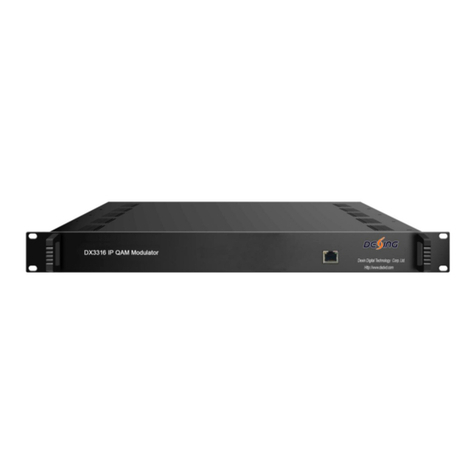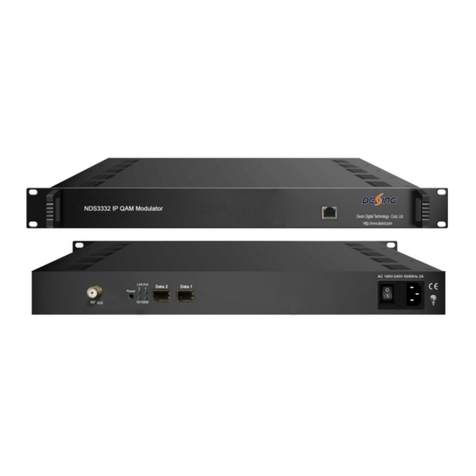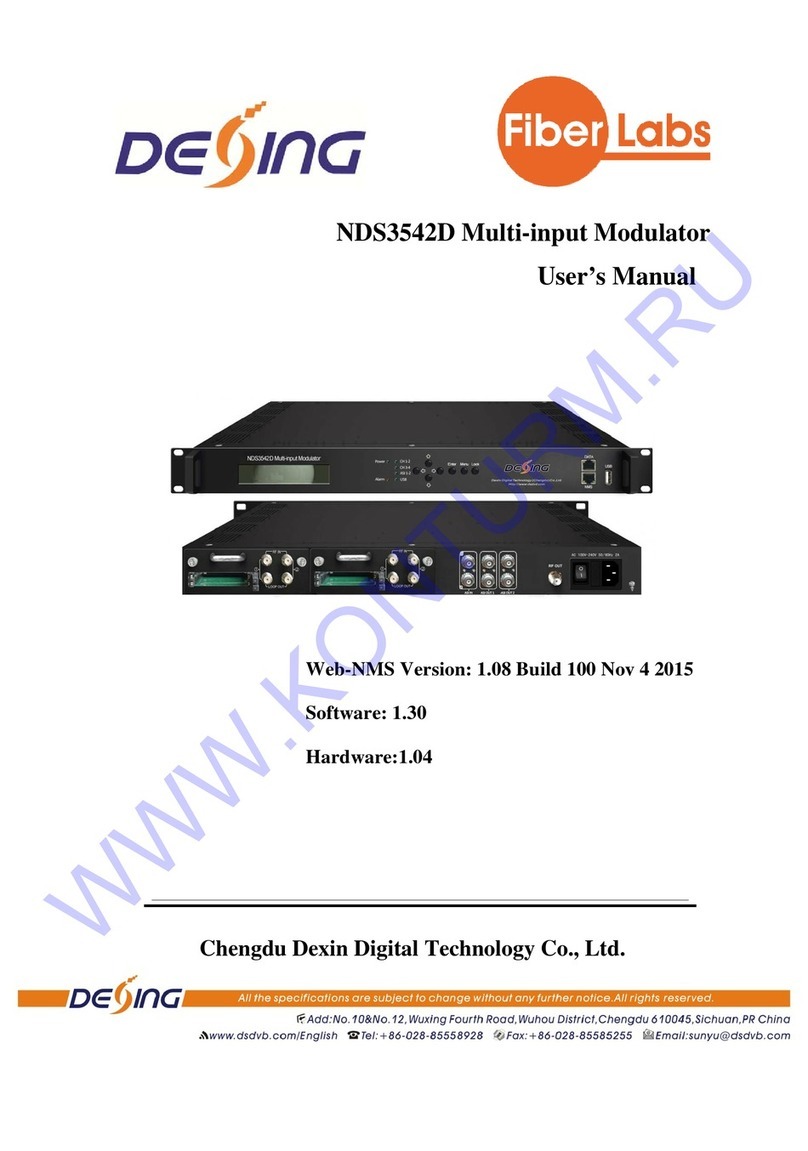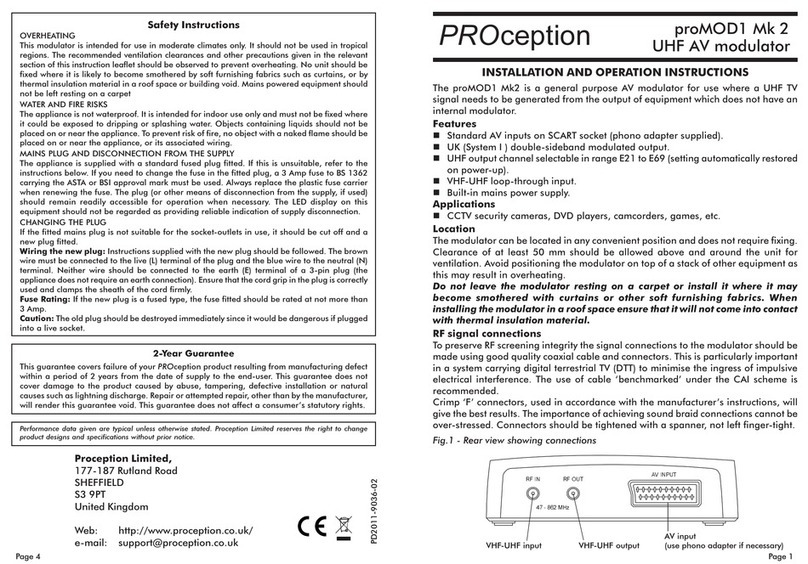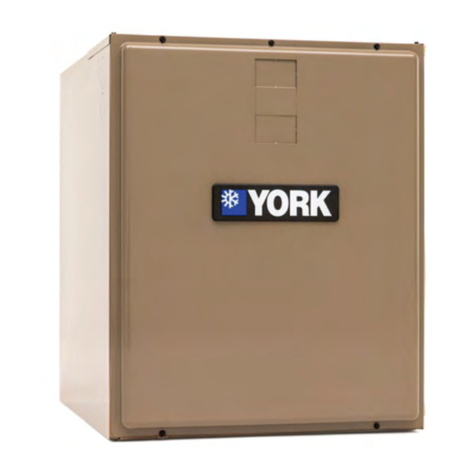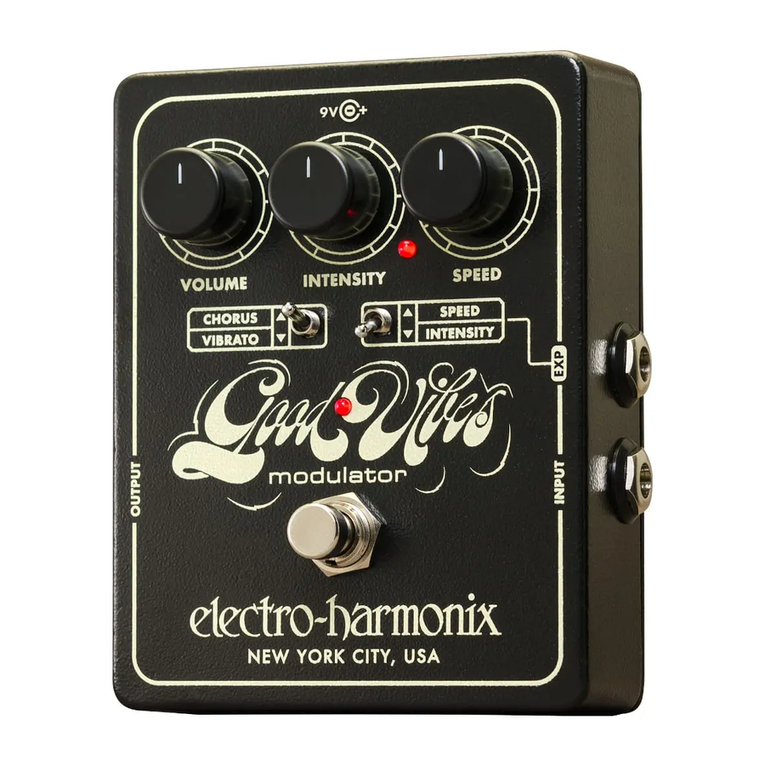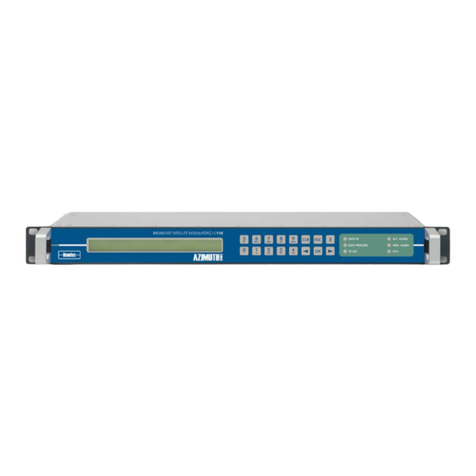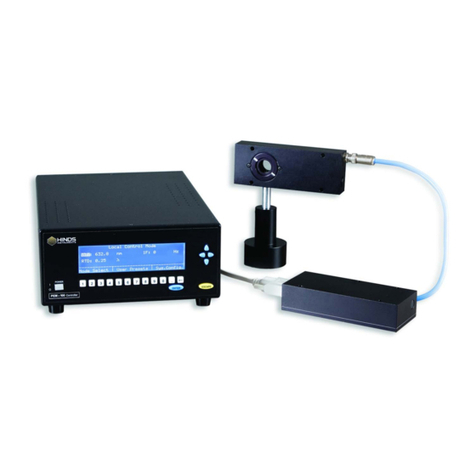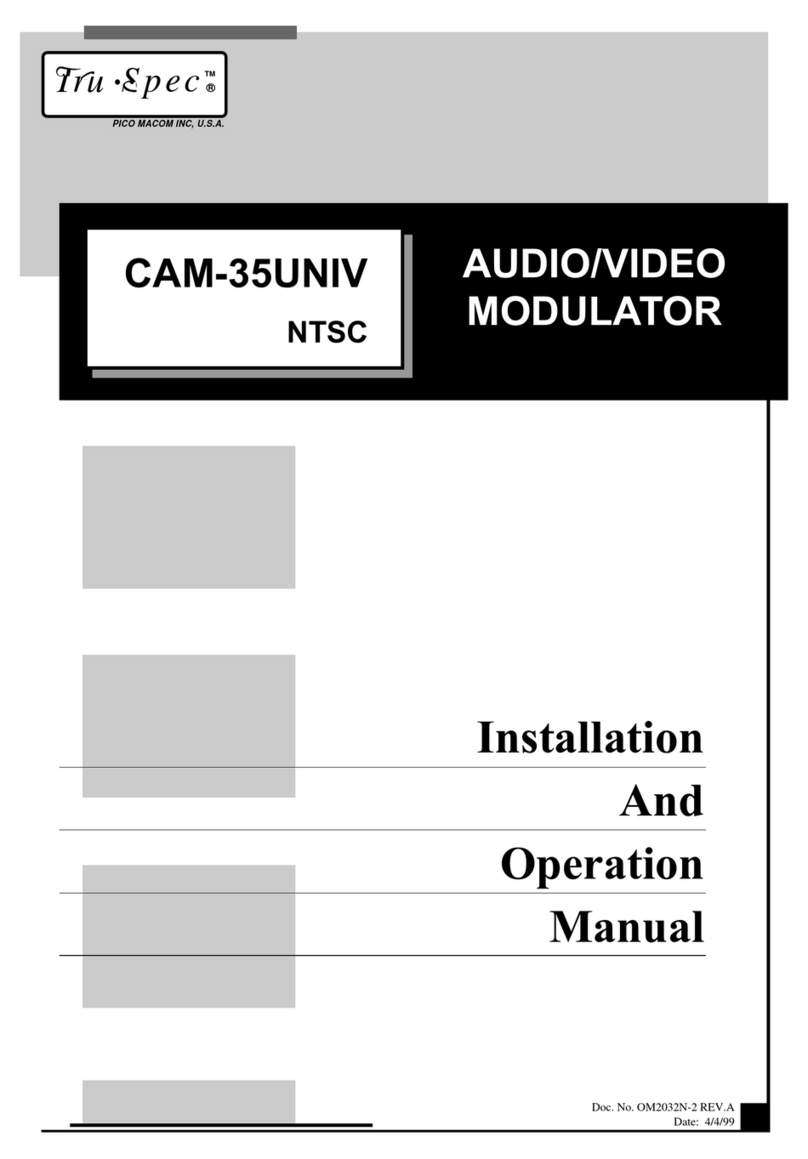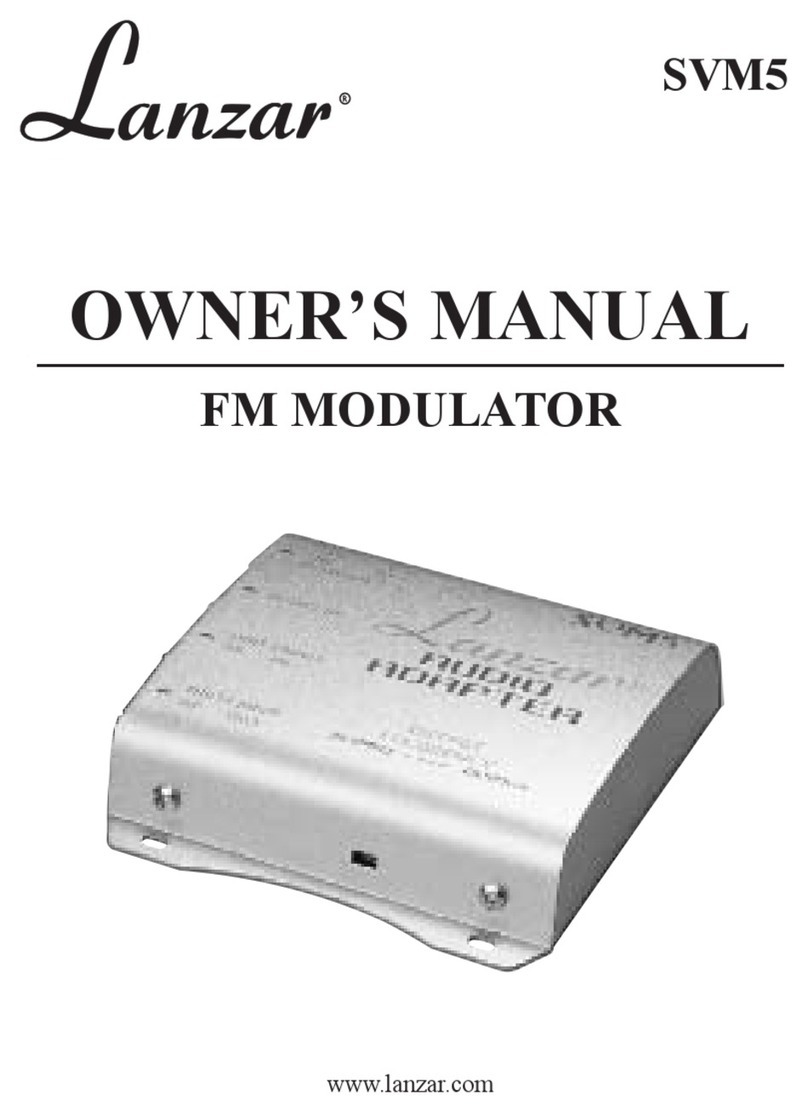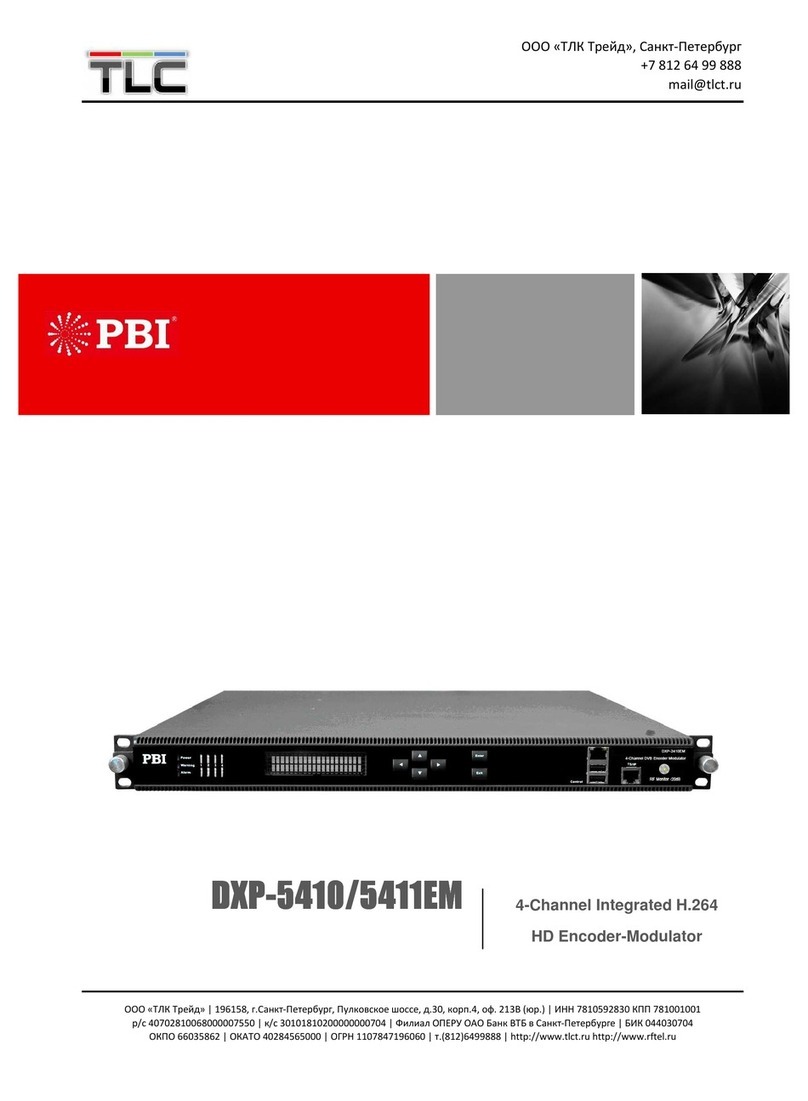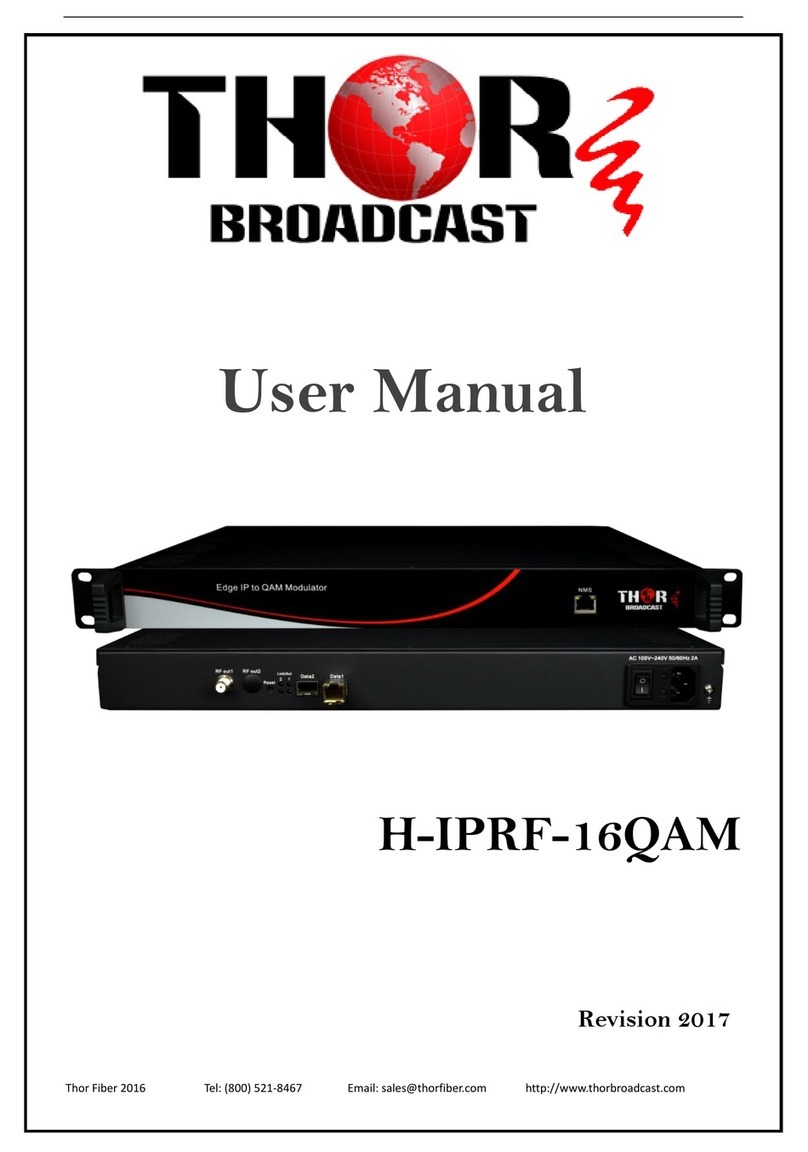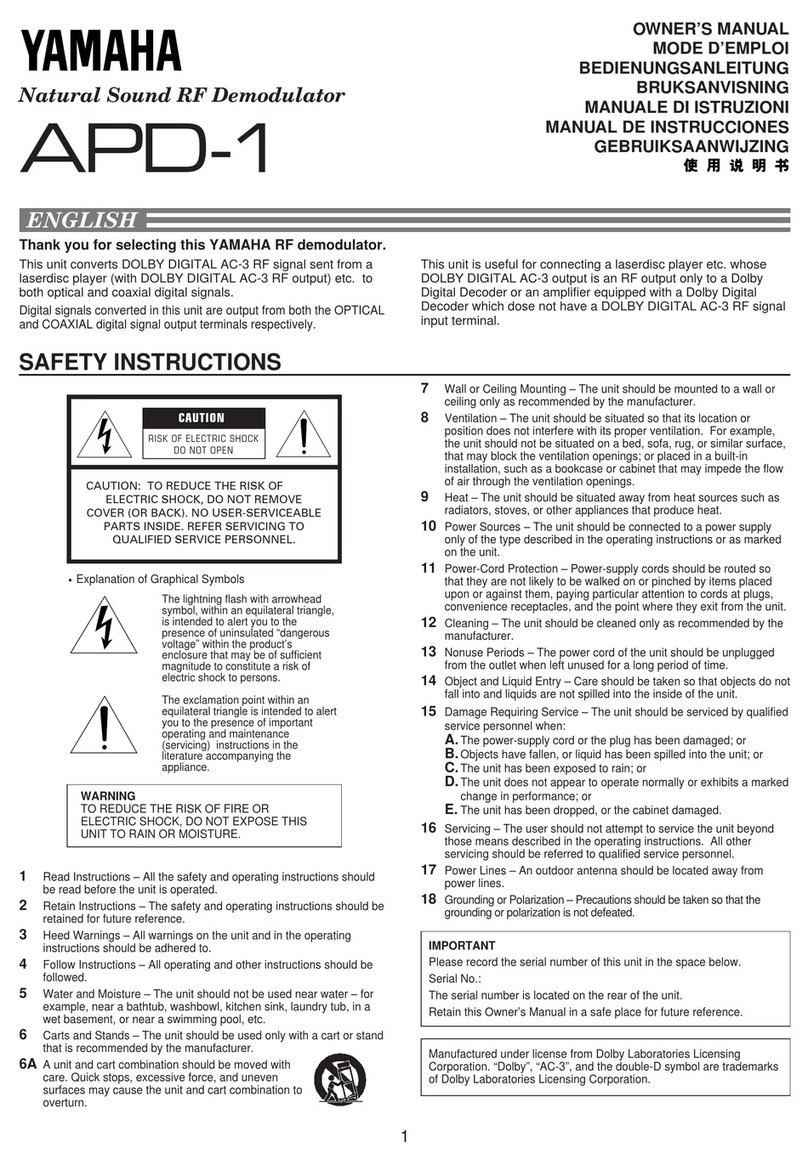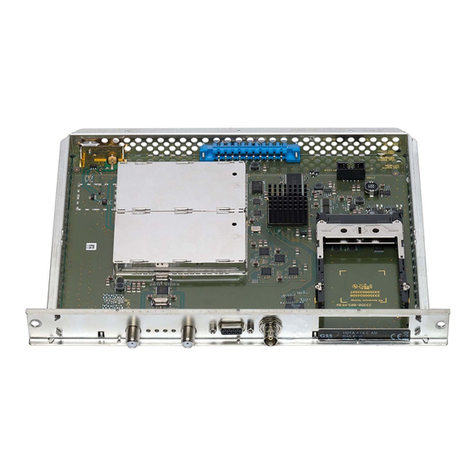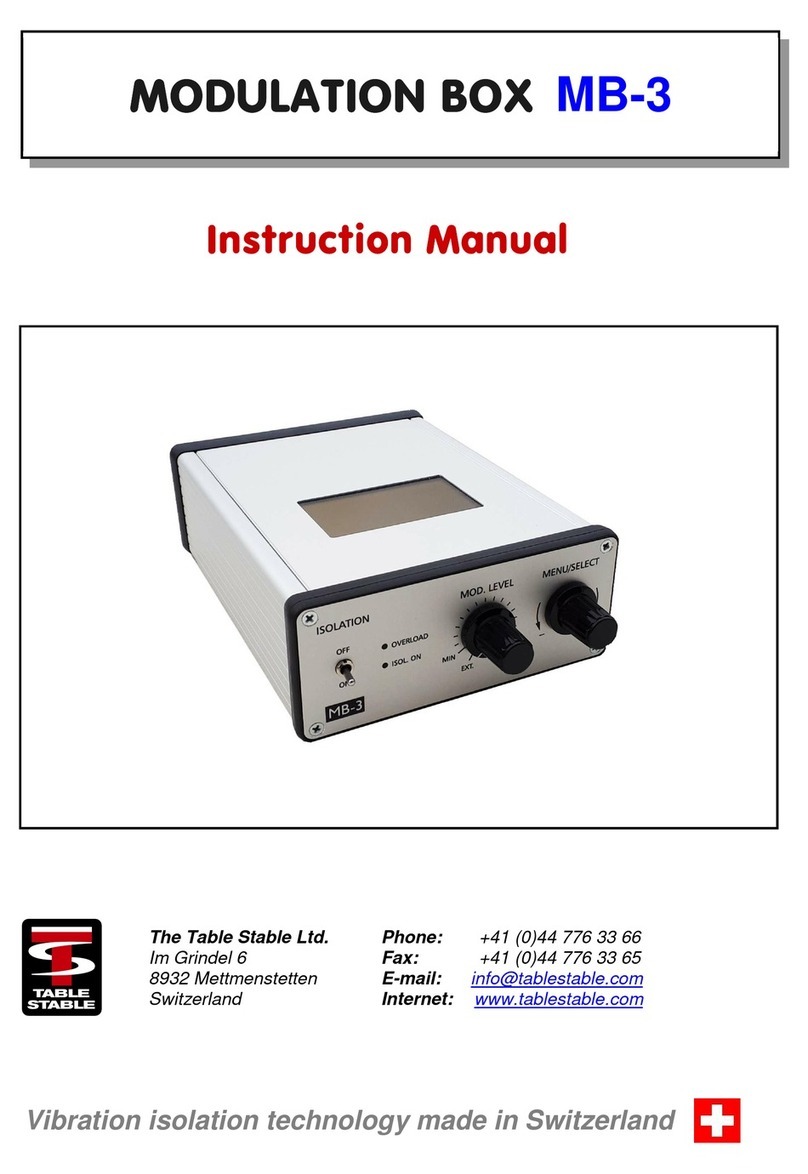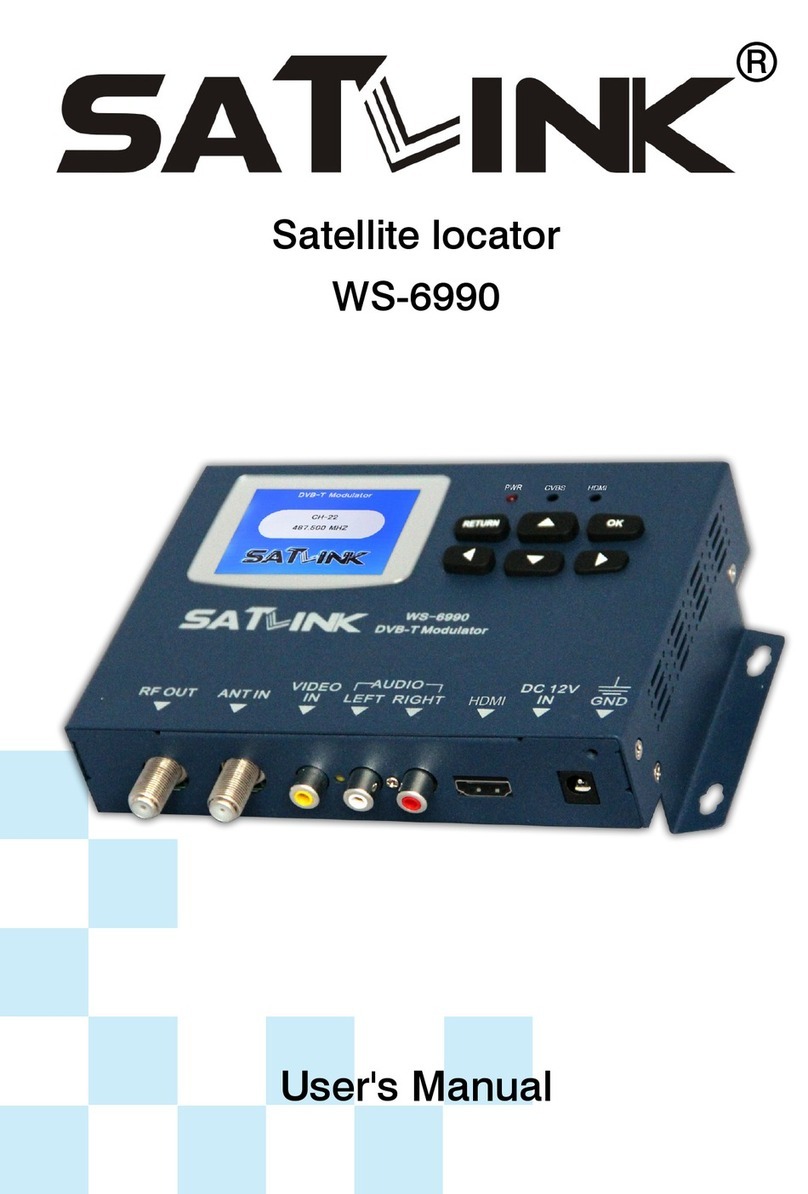Dexing NDS3306I User manual

NDS3306I 6 in 1 ISDB-T Modulator
User Manual
DEXIN DIGITAL TECHNOLOGY CORP. LTD.
Add: No. 10 and 12, Wuxing Fourth Road, Wuhou District Chengdu 610045, Sichuan, PR China
www.dsdvb.com/english Tel:+86-028-85550524 Fax: +86-028-85585255 Email:[email protected]

About This Manual
Intended Audience
This user manual has been written to help people who have to use, to integrate
and to install the product. Some chapters require some prerequisite knowledge in
electronics and especially in broadcast technologies and standards.
Disclaimer
No part of this document may be reproduced in any form without the written
permission of the copyright owner.
The contents of this document are subject to revision without notice due to
continued progress in methodology, design and manufacturing. DEXIN shall have
no liability for any error or damage of any kind resulting from the use of this
document.
Copy Warning
This document includes some confidential information. Its usage is limited to the
owners of the product that it is relevant to. It cannot be copied, modified, or
translated in another language without prior written authorization from DEXIN.

Directory
Chapter 1 Product Overview............................................................................................1
1.1 Outline..........................................................................................................................1
1.2 Inner Structure............................................................................................................1
1.5 Specifications................................................................................................................2
Chapter 2 Physical Presentational Statement.................................................................2
2.1 Front panel Illustration: .............................................................................................4
2.2 Rear panel Illustration:...............................................................................................4
Chapter 3 Installation Guide............................................................................................5
3.1 Acquisition Check........................................................................................................5
3.2 Installation Preparation..............................................................................................5
Chapter 4 Web NMS Management..................................................................................8
4.1 Login.............................................................................................................................8
4.2 Operation......................................................................................................................8
Chapter 5 Troubleshooting.............................................................................................20

NDS3306I 6 in 1 ISDB-T Modulator User Manual
1
Chapter 1 Product Overview
1.1 Outline
NDS3306I 6 in 1 ISDB-T modulator is the latest generational Mux-modulating device
developed by DEXIN. It has 6 multiplexing channels and 6 (ISDB-Tb) modulating
channels, and supports maximum 192 IP input through the 3 GE ports and 6
non-adjacent carriers (50MHz~960MHz) output through the RF output interface. The
device is also characterized with high integrated level, high performance and low cost.
This is very adaptable to newly generation DTV broadcasting system.
1.2 Key Features
3 GE ports (max 192 IP in):
Data1 & Data2 bi-directional ports, max 192 IP in, 6 IP out
Data port (located on front panel), max 128 IPin
Max 840Mbps for each GE input
Supports accurate PCR adjusting
Supports CAfiltering, PID remapping and PSI/SI editing
Supports up to 180 PIDS remapping per channel
Support 6 IPoutput through Data1 & Data2 over UDP/RTP/RTSP
6 non-adjacent carriers output, compliant to ISDB-Tb (ARIB STD-B31)
Support Web-based Network management
1.3 Inner Structure
MUX 1#
192 IP
MPTS or SPTS
ISDB 1# IP 1
Carrier 1
MUX 6# ISDB 6# Carrier 6
IP 6
Data1
Data2
Data
(front panel)

NDS3306I 6 in 1 ISDB-T Modulator User Manual
2
1.4 Carrier Setting Illustration
1.5 Specifications
Input
Input
Max 192 IP input through 3 (front-panel Data
port, Data 1 and Data 2) 100/1000M Ethernet Port
(SFP interface optional). Each Data1 or Data 2
port can input max 192 IP, while front-panel Data
port can input max 128 IP
Transport Protocol
TS over UDP/RTP, unicast and multicast, IGMP
V2/V3
Transmission Rate
Max 840Mbps for each GE input
Mux
Input Channel
192
Output Channel
6
Max PIDs
180 per channel
Functions
PID remapping (auto/manually optional)
PCR accurate adjusting
PSI/SI table automatically generating
Modulation
Parameters
Standard
ARIB STD-B31
Bandwidth
6M
Constellation
QPSK, 16QAM, 64QAM
Guard Interval
1/32, 1/16, 1/8, 1/4
Transmission Mode
2K, 4K, 8K
Code rate
1/2, 2/3, 3/4, 5/6, 7/8
MER
≥40dB
RF frequency
50~960MHz, 1KHz step
RF output level
-20dBm~+10dBm(87~117dbµV), 0.1dB stepping
RF Output
Interface
1 F typed output port for 6 carriers, 75Ω

NDS3306I 6 in 1 ISDB-T Modulator User Manual
3
impedance
ACLR
-50 dBc
TS output
6 IP output over UDP/RTP/RTSP, unicast/multicast, 2 (Data1& Data2)
100/1000M Ethernet Ports
System
Network management software (NMS) supporting
General
Demission
420mm×440mm×44.5mm (WxLxH)
Weight
3kg
Temperature
0~45℃(operation), -20~80℃(storage)
Power Supply
AC 100V±10%, 50/60Hz or AC 220V±10%,
50/60Hz
Consumption
15.4W

NDS3306I 6 in 1 ISDB-T Modulator User Manual
4
Chapter 2 Physical Presentational Statement
2.1 Front panel Illustration:
2.2 Rear Panel Illustration:
1
NMS/CAS: network management port and CA data port
2
DATA input port
3
Indicators
4
Grounding
5
Power switch
6
AC Power Socket
7
RF output port
8
Reset IP: Reset webmaster IP address, recover it to default IP address
9
Data Input /Output 1/2
5
6
7
8
9
1
4
2
3

NDS3306I 6 in 1 ISDB-T Modulator User Manual
5
Chapter 3 Installation Guide
3.1 Acquisition Check
When user opens the package of the device, it is necessary to check items according to
packing list. Normally it should include the following items:
NDS3306I 6 in 1 ISDB-T Modulator
User’s Manual
Power Cord
If any item is missing or mismatching with the list above, please contact local dealer.
3.2 Installation Preparation
When users install device, please follow the below steps. The details of installation will be
described at the rest part of this chapter. Users can also refer rear panel chart during the
installation.
The main steps of the installation include:
Checking the possible device missing or damage during the transportation
Preparing relevant environment for installation
Installing NDS3306I 6 in 1 ISDB-T Modulator
Connecting signal cables
Connecting communication port (if it is necessary)
3.2.1 Device’s Installation Flow Chart Illustrated as follows:
Connecting
Grouding
Wire and
Power
Cord
Acquisition
Check Fixing
Device Setting
Parameter Running
Device
Connecting
Signal Wire
3.2.2 Environment Requirement

NDS3306I 6 in 1 ISDB-T Modulator User Manual
6
3.2.3 Grounding Requirement
All function modules’ good grounding is the basis of reliability and stability of devices.
Also, they are the most important guarantee of lightning arresting and interference
rejection. Therefore, the system must follow this rule.
Coaxial cables’ outer conductor and isolation layer should keep proper electric
conducting with the metal housing of device.
Item
Requirement
Machine Hall Space
When user installs machine frame array in one machine hall, the
distance between 2 rows of machine frames should be 1.2~1.5m and
the distance against wall should be no less than 0.8m.
Machine Hall Floor
Electric Isolation, Dust Free
Volume resistivity of ground anti-static material: 1X107~1X1010,
Grounding current limiting resistance: 1M (Floor bearing should be
greater than 450Kg/㎡)
Environment
Temperature
5~40℃(sustainable ), 0~45℃(short time)
installing air-conditioning is recommended
Relative Humidity
20%~80% sustainable 10%~90% short time
Pressure
86~105KPa
Door & Window
Installing rubber strip for sealing door-gaps and dual level glasses
for window
Wall
It can be covered with wallpaper, or brightness less paint.
Fire Protection
Fire alarm system and extinguisher
Power
Requiring device power, air-conditioning power and lighting power
are independent to each other. Device power requires AC power
220V ±10% 50/60Hz or 110V ±10% 50/60Hz. Please carefully
check before running.

NDS3306I 6 in 1 ISDB-T Modulator User Manual
7
Grounding conductor must adopt copper conductor in order to reduce high frequency
impedance, and the grounding wire must be as thick and short as possible.
Users should make sure the 2 ends of grounding wire well electric conducted and be
antirust.
It is prohibited to use any other device as part of grounding electric circuit
The area of the conduction between grounding wire and device’s frame should be no
less than 25mm2.
3.2.4 Frame Grounding
All the machine frames should be connected with protective copper strip. The grounding
wire should be as short as possible and avoid circling. The area of the conduction between
grounding wire and grounding strip should be no less than 25mm2.
3.2.5 Device Grounding
Connecting the device’s grounding rod to frame’s grounding pole with copper wire.
3.3 Wire’s Connection
3.3.1 Power cord connection
The power socket is located on the right of rear panel, and the power switch is on the left
of front panel. User can plug one end of the power cord to the socket and insert the other
end to AC power. When the device solely connects to protective ground, it should adopt
independent way, say, share the same ground with other devices. When the device adopts
united way, the grounding resistance should be smaller than 1Ω.
Caution: Before connecting power cord to NDS3306I 6 in 1 ISDB-T Modulator, user
should set the power switch to “OFF”.
3.3.2 Signal and NMS Cable Connection
The signal connections include the connection of input signal cable and the connection of
output signal cable.

NDS3306I 6 in 1 ISDB-T Modulator User Manual
8
Chapter 4 Web NMS Management
This device does not support the LCD operation, and the modification can only be operated
under Web NMS.
4.1 Login
The default IP address of this device is 192.168.0.136.
Connect the PC (Personal Computer) and the device with a net cable, and use ping
command to confirm they are on the same network segment. For instance, the PC IP address
is 192.168.99.252, we then change the device IP to 192.168.99.xxx (xxx can be 0 to 255
except 252 to avoid IP conflict).
Launch the web browser an input the device IP address in the browser’s address bar and
press Enter.
It will display the Login interface as Figure-1. Input the Username and Password (Both the
default Username and Password are “admin”. And then click “Login” to start the device
setting.
Figure-1
4.2 Operation
4.2.1 Summary
When we confirm the login, it will display the summary interface as Figure-2.

NDS3306I 6 in 1 ISDB-T Modulator User Manual
9
Figure-2
4.2.2 Monitor
Monitor → Input Status:
Clicking “Input Status”, it will display the interface as Figure-3 where users can check the
input status of Data1 and Data 2. Users need to add IP in “TS Config”part. Otherwise, it
will monitor nothing.
Figure-3
Monitor → Output Status:
Clicking “Output Status”, it will display the interface as Figure-4/5 where users can check
User can click any item here to
enter the corresponding interface
to check information or set the
parameters.

NDS3306I 6 in 1 ISDB-T Modulator User Manual
10
output status of the 6 carriers and 6 IPs. User need to enable the output status in
“Modulator”and “IP Stream”part. Otherwise, it will monitor nothing.
Figure-4
Figure-5
4.2.3 Parameters
Parameters → TS Config:
Click “TS Config”, it will display the interface where users can configure the output TS
parameters in this interface. (Figure-6)

NDS3306I 6 in 1 ISDB-T Modulator User Manual
11
Figure-6
Output TS X
Clicking “Output TS X”, it will display the interface as Figure-7. Users can select the
output TS channels.
Figure-7
Stream Select
Clicking “Stream Select”, it will display the interface where users can choose the
programs to Mux out. (Figure-8)
To select output TS channel 1-6

NDS3306I 6 in 1 ISDB-T Modulator User Manual
12
Figure-8
Configure ‘Input Area’and ‘Output Area’with buttons in ‘Operation Area’. Instructions are
as below:
: To add input channel which come from Data1 or Data 2 or Data/Module
: To edit the input channel
: To delete the input channel
: To delete all inputs channel
: To check input IP lock or not, green means current IP locked
: To check current TS overflow or not, red color means current TS
overflow, need reduce program
:Enable/disable the CA Filter function. Clicking the box, user can filter the input
CA to avoid disturbing with the device scrambling function.
: To enable/disable the PID remapping
To refresh the input program information
To refresh the output program information
Select one input program first and click this button to transfer the selected
program to the right box to output.
Similarly, user can cancel the multiplexed programs from the right box.
To select all the input programs
To select all the output programs
Input Area
Output Area
Operation Area
Set output IP address of
streamer

NDS3306I 6 in 1 ISDB-T Modulator User Manual
13
To parse programs time limitation of parsing input programs
Program Modification:
The multiplexed program information can be modified by clicking the program in the
‘output’area. For example, when clicking , it triggers a dialog
box (Figure 9) where users can input new information.
Figure-9
General
Clicking “General”, it will display the interface where users can set parameters for each
output channel. (Figure-10)
Figure-10
PID Pass
Clicking “PID Bypass”, it will display the interface as Figure-11 where user can add PIDs
to be passed, click the “+”symbol, input current IP channel number, then input current IP

NDS3306I 6 in 1 ISDB-T Modulator User Manual
14
source PID and output PID which is customer needed , then click “set”to apply the
parameters.
Figure-11
Parameters → Modulator:
Clicking ‘Modulator’, it will display the interface as Figure-12 where to set RF output
parameters.
Figure-12
When users click “quickly config”button, it triggers a dialog box as follow where users can
set all channels configration.
Click“Channel config”
to set each channel RF
output parameters
Click “quickly config”
to set all channels RF
output parameters

NDS3306I 6 in 1 ISDB-T Modulator User Manual
15
When users click “Channel config”button, it triggers a dialog box as follow where users can
set the corresponding channel configration.
Parameters → IP Stream:
NDS3306I supports TS to output in IP (6*MPTS) format through the DATA port.
Clicking ‘IP Stream’, it will display the interface as Figure-13 where to set IP out
parameters.
Figure-13
When users click “Quickly Config”button, it triggers a dialog box where users can set all
channels MPTS configration simultaneously.
Quickly Config
Channel Config
Click the box to enable the status

NDS3306I 6 in 1 ISDB-T Modulator User Manual
16
When users click “Channel Config”button, it triggers a dialog box where users can set
corresponding MPTS channel configration.
4.2.4 System
System →Network:
Clicking ‘Network’, it will display the interface as Figure-14 where to set network
parameters.
Figure-14
System →Password:
Clicking “Password”, it will display the screen as Figure-15 where to set the login account
and password for the web NMS.
Click to enable the status and select
TS out thru Data 1 or Data 2
Set output IP address
Set data port IP address
Set NMS IP address and login to
management device. The default IP
address is 192.168.0.136

NDS3306I 6 in 1 ISDB-T Modulator User Manual
17
Figure-15
System →Configuration:
Clicking “Configuration”, it will display the screen as Figure-16 where to set your
configurations for the device.
Figure-16
System →Firmware:
Clicking “Firmware”, it will display the screen as Figure-17 where to update firmware for
the device.
Select areas
Table of contents
Other Dexing Modulator manuals
